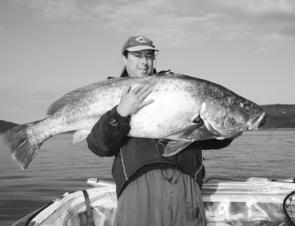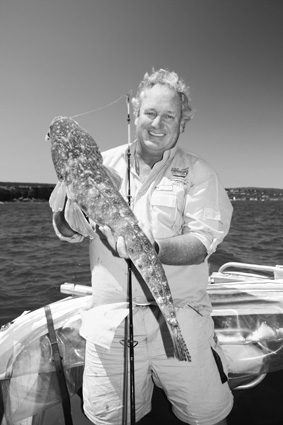The salmon are on the boil and are moving further into the Harbour every week. They have been spotted up around Rose Bay and we have caught a few at Fairlight Point but the main concentrations so far have still been near the Heads.
Bonito have made a welcome return after some very sparse years and are in good numbers around South Head. They haven’t hit the surface yet but can be located by trolling deep-divers or letting your metal lures sink below the salmon schools. If things go to plan, the salmon and bonito should be working the surface well up into the Harbour and will be taking any size lure by the time you read this.
If you want to consistently catch jewies you must crack the formula down to every last detail. Unlike most other fish you won’t get by just having half of it solved. A month or so back I reported being involved in the capture of Jewie Jim Siriakas’ 30kg monster jew on the Hawkesbury. One month later I went back with my mate Jobby to put the formula to the test and came up with another of similar size. The sense of deja vu was almost spooky.
We put exactly the same bait in exactly the same spot on exactly the same moon phase to the day and the fish took the bait dead on slack water, as before.
Kingfish, on the other hand, have a high metabolism so they are hungrier more often than jewfish. This gives us the leeway of being able to get some parts of the kingie formula wrong – sometimes. In other words, you simply won’t get as many shots at jewies as you will at kings and therefore must work harder at filling the jewfish formula to achieve consistent results.
I’m not going to lay out the whole formula for you because I’d get necked by the guys who have but in the hard yards and also because the exhilaration of your first jewfish comes from having put in the hard yards yourself. But here are a few starting points.
Use big baits, preferably squid, on the bottom. Jewies are a year-round fish so don’t neglect the Winter months.
The week leading up to the new moon and full moon are prime times. There are prime days within these weeks but you will have to work them out yourself. The week after the full moon is a waste of time.
All of my biggest fish have been caught on the slack water of the full tide but the last hour of the run up and the first hour of the run out are good times. Jewies prefer major points, bends, holes and structure like bridge pylons and wrecks.
The flatties have fired up with the warm weather. Flathead are well distributed right throughout the Harbour from the uppermost reaches to the Heads. The lower reaches around the Heads are dominated by the smaller sand flathead commonly encountered offshore with the occasional dusky thrown in, especially when using larger live baits.
Upstream is the exclusive domain of the dusky which, despite growing to considerable size, is comfortable in as little as 30cm of water.
Flatties have a reputation as being a poor sport fish, which holds true when using bait techniques but can be totally disregarded when they are targeted with lures. The skill, thrill and anticipation involved in hunting flatties on lures is little different from that of any other predatory species including the tropical glamour fish.
Although the fight from a lure-caught flathead bears little resemblance to that of the northern mangrove inhabitants, it is a huge improvement over a flathead caught on bait. In the clearer water often found in the upper reaches of Middle Harbour and the Lane Cove River, there's the added appeal of the visual thrill of seeing the hooked fish in action.
Some of the best areas in the Harbour to lure-fish for flatties include the shallows of Rose Bay, the upper reaches of Middle Harbour, the entire length of the Lane Cove River, Iron Cove and the Parramatta River from Gladesville bridge upstream.
The best time to work these areas is two hours before low tide and one hour after it starts to come back in. It’s even better if this tide occurs early morning or late afternoon.
Flathead congregate around channel edges, rock bars, weed banks and sand/mud bank drop-offs. Any area where water is channelled off mangrove stands or flats on a falling tide is well worth a throw.
A single-handed spinning or light baitcasting outfit loaded with 3kg or 4kg line will handle any flathead provided you use a more substantial trace of about 10kg.
Flathead will hit almost anything that swims past. With the emphasis on presenting the lure close to the fish, depth capabilities are the major consideration when choosing a lure for flatties.
Considering you will be fishing depths from 30cm to 5m you'll need quite a large selection of lures should you opt for diving minnow styles.
A more versatile and possibly more effective option is to carry two types of soft plastic lures. For the shallows (30cm to 1.5m) a soft stickbait is deadly on flatties, especially around weed. To cover all depths it’s hard to go past a soft plastic pre-rigged on a jig head like those from Kokoda or Storm.
Flounder are a welcome by-catch of flattie luring and generally favour the same areas, although they prefer the deeper sand banks. If you would like to target flounder, drop down your lure size to something around 5cm.
Reads: 1955
A month to the hour after the 32kg fish pictured on the October NSWFM cover was caught, the author nailed an identical fish in the same spot.

Salmon should be in good numbers well inside the Harbour this month.

Everybody’s Summer favourites, the flathead, are well and truly back on the agenda.

Flounder are a welcome by-catch of flattie luring and generally favour the same areas,




